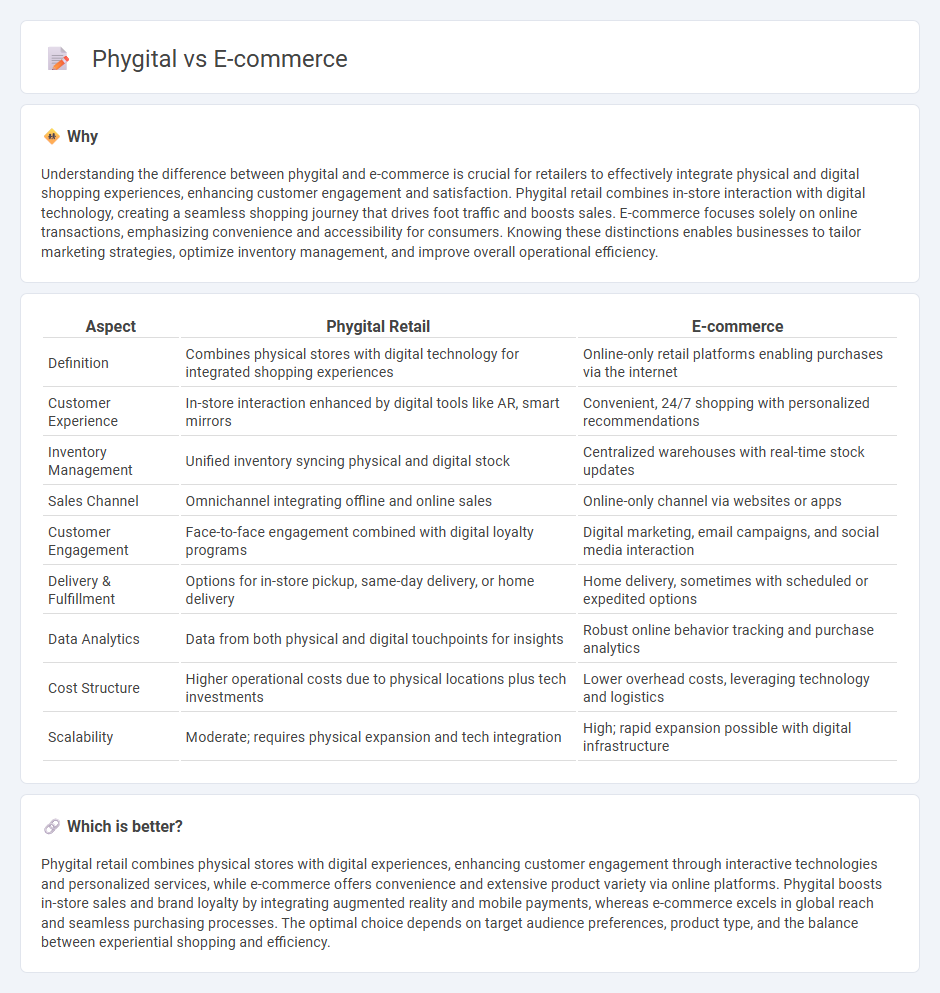
Phygital retail combines physical store experiences with digital technology to create seamless shopping journeys, enhancing customer engagement and satisfaction beyond traditional e-commerce platforms. While e-commerce focuses solely on online transactions, phygital strategies integrate interactive displays, augmented reality, and mobile apps to bridge the gap between online convenience and in-store immersion. Explore how phygital retail is reshaping consumer behavior and driving innovation in the retail industry.
Why it is important
Understanding the difference between phygital and e-commerce is crucial for retailers to effectively integrate physical and digital shopping experiences, enhancing customer engagement and satisfaction. Phygital retail combines in-store interaction with digital technology, creating a seamless shopping journey that drives foot traffic and boosts sales. E-commerce focuses solely on online transactions, emphasizing convenience and accessibility for consumers. Knowing these distinctions enables businesses to tailor marketing strategies, optimize inventory management, and improve overall operational efficiency.
Comparison Table
| Aspect | Phygital Retail | E-commerce |
|---|---|---|
| Definition | Combines physical stores with digital technology for integrated shopping experiences | Online-only retail platforms enabling purchases via the internet |
| Customer Experience | In-store interaction enhanced by digital tools like AR, smart mirrors | Convenient, 24/7 shopping with personalized recommendations |
| Inventory Management | Unified inventory syncing physical and digital stock | Centralized warehouses with real-time stock updates |
| Sales Channel | Omnichannel integrating offline and online sales | Online-only channel via websites or apps |
| Customer Engagement | Face-to-face engagement combined with digital loyalty programs | Digital marketing, email campaigns, and social media interaction |
| Delivery & Fulfillment | Options for in-store pickup, same-day delivery, or home delivery | Home delivery, sometimes with scheduled or expedited options |
| Data Analytics | Data from both physical and digital touchpoints for insights | Robust online behavior tracking and purchase analytics |
| Cost Structure | Higher operational costs due to physical locations plus tech investments | Lower overhead costs, leveraging technology and logistics |
| Scalability | Moderate; requires physical expansion and tech integration | High; rapid expansion possible with digital infrastructure |
Which is better?
Phygital retail combines physical stores with digital experiences, enhancing customer engagement through interactive technologies and personalized services, while e-commerce offers convenience and extensive product variety via online platforms. Phygital boosts in-store sales and brand loyalty by integrating augmented reality and mobile payments, whereas e-commerce excels in global reach and seamless purchasing processes. The optimal choice depends on target audience preferences, product type, and the balance between experiential shopping and efficiency.
Connection
Phygital retail integrates physical store experiences with e-commerce platforms to create seamless, multichannel customer journeys. By leveraging technologies like augmented reality and click-and-collect services, retailers enhance engagement and convenience across both online and offline channels. This fusion drives increased sales, improved customer satisfaction, and data-driven personalization in retail strategies.
Key Terms
Omnichannel
E-commerce leverages digital platforms to facilitate online purchasing, while phygital integrates physical and digital experiences to create seamless customer interactions. Omnichannel strategies unify these approaches by ensuring consistent brand engagement across online stores, mobile apps, and brick-and-mortar locations. Explore how combining e-commerce and phygital tactics can enhance customer loyalty and drive sales growth.
Customer Experience
E-commerce offers customers the convenience of shopping anytime with extensive product selections and personalized recommendations powered by AI algorithms. Phygital retail combines physical store interactions with digital enhancements, creating immersive experiences such as virtual try-ons and real-time inventory updates to boost customer engagement. Explore how integrating e-commerce and phygital strategies can revolutionize your customer experience.
Digital Integration
E-commerce leverages online platforms to facilitate seamless digital transactions, offering convenience and extensive product availability through digital integration technologies such as AI-driven recommendations and secure payment gateways. Phygital combines physical retail experiences with digital elements like augmented reality and real-time inventory tracking, enhancing customer engagement by bridging offline and online channels. Explore deeper insights into how digital integration differentiates e-commerce and phygital strategies.
Source and External Links
What Is Ecommerce? Guide To Selling Online (2025) - Shopify - Ecommerce is the buying and selling of goods and services over the internet, involving transactions that can be business-to-consumer, business-to-business, or consumer-to-consumer, and encompasses various forms like online retail, digital downloads, subscriptions, and more.
Glossary:E-commerce - Statistics Explained - Eurostat - Ecommerce broadly means the sale or purchase of goods or services through electronic transactions via the internet or other computer-mediated networks, including activities like ordering online, paying online, and confirming reservations.
Ecommerce (Learn About the Evolution of Online Shopping) - BigCommerce explains ecommerce benefits such as reaching a global audience 24/7, scaling operations through automation, gaining valuable customer insights, and enabling businesses to sell internationally with the support of data analytics and marketing tools.
 dowidth.com
dowidth.com